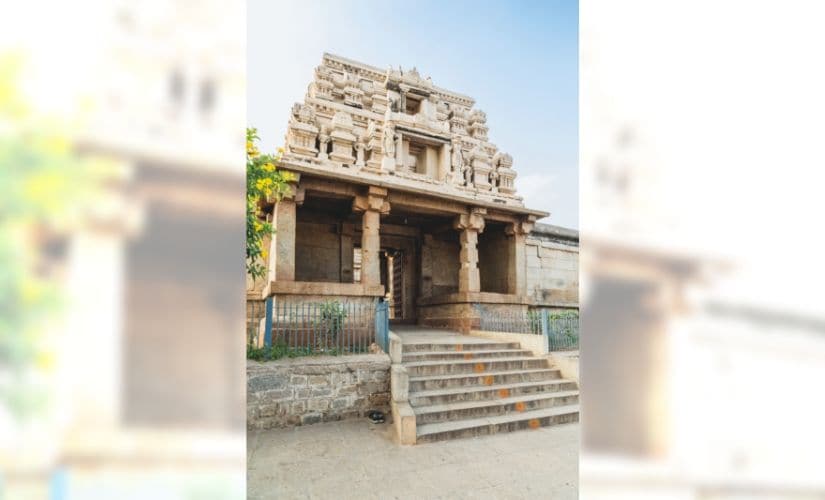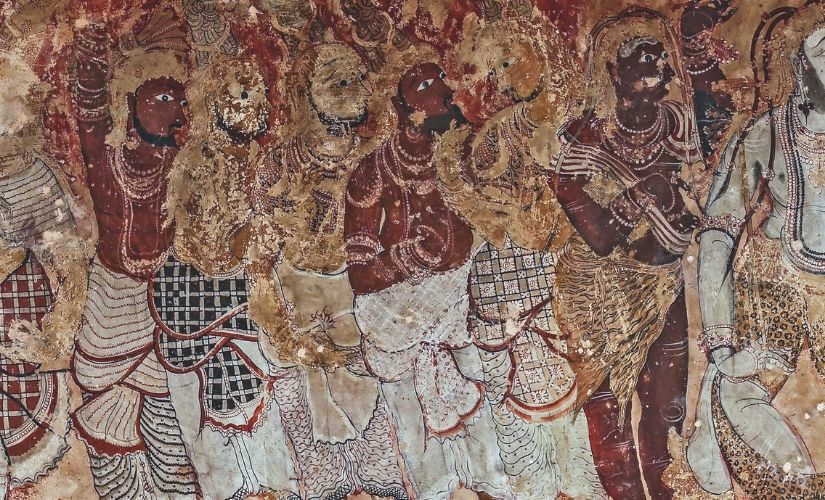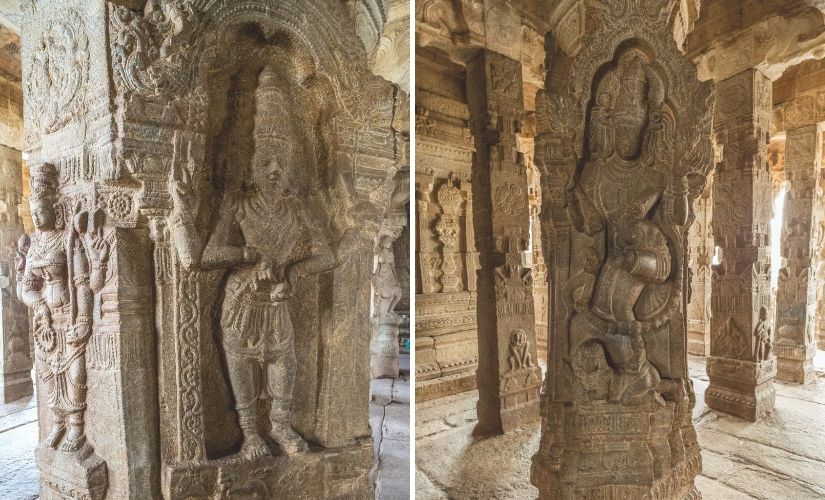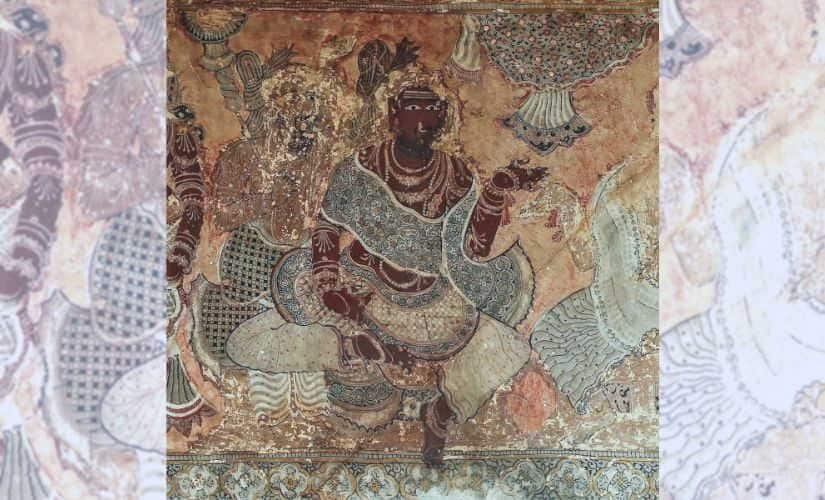Among the several temples dotting Andhra Pradesh — with one overshadowing the other in grandeur and architectural finesse — the Lepakshi temple in Rayalaseema always stands out, adorned by stunning sculptures and ancient paintings. A new book, Lepakshi: Architecture, Sculpture and Painting, by Anna L Dallapiccola, Brigitte Khan Majlis, and George Michell with John M Fritz, explores the history and artistic features of the structure that’s hidden away in a remote part of the state. Despite being at a stone’s throw distance from Bengaluru, this pocket remains an under-explored gem in the region. Divided into different, uneven complexes, most of the temple is built on a low-lying rocky hill known as Kurmasailam, meaning ‘Tortoise Hill’ in Telugu (as suggested by its shape). [caption id=“attachment_7215381” align=“alignnone” width=“825”]  Cover of Lepakshi: Architecture, Sculpture and Painting.[/caption] Among the many stories surrounding the temple’s origins, one such local lore suggests that it dates back to the time of the Ramayana. Lepakshi is widely believed to have received its name from the episode of Jatayu being slain by Ravana, while abducting Sita. This was the place where the mighty bird fell, and Ram, on coming across the wounded Jatayu, kindly said, “Le, pakshi,” (“Rise, bird,” in Telugu) before healing him. It was rebuilt in the 16th century under the Vijayanagara kingdom. Another version says that the temple was built by the sage Agastya, in order to appease Veerabhadra, the fiery offspring of Lord Shiva, born from a lock of his hair. While the guides and the priests of the temple believe that it’s millennia old, Dallapiccola realistically puts things into perspective and says, “Although tradition links the foundation of the temple with the great sage Agastya, the only available historical sources are the inscriptions found in the monument. These clearly mention the patronage of the temple by Virapanna, the representative of the Vijayanagara king, Achyutaraya (r. 1520-42), in the Penukonda region, where the temple is located. From the time span covered by the inscriptions, it appears that the main artistic activity was between 1531-1541 CE.” Having first visited the temple in 1979, she admits that the paintings were the main reason for her being attracted to Lepakshi. [caption id=“attachment_7215441” align=“alignnone” width=“825”]  The outer north gate of the Lepakshi temple in Andhra Pradesh’s Rayalaseema.[/caption] The scholar, who is currently involved with a research project on the artistic traditions of the successor states of the Vijayanagara kingdom in southern India, has previously worked on the art and architecture of the region extensively. “Dr George Michell and I started thinking about a monograph on Lepakshi in 2014, after having contributed to a book, Rayalaseema: The Royal Realm, published by Marg,” she says, and adds that “although a number of distinguished Indian scholars have written about this monument", they felt that “there was need for a comprehensive survey of the site with an extensive photographic documentation.” “In order to cover all the aspects of the monument, we invited Mrs B Khan Majlis to write on the textiles depicted on the murals, and Dr John Fritz contributed a small section on the game boards carved on the floor,” Dallapiccola informs. The Lepakshi temple, considered one of the most sought after Veerabhadra temples in the region, exemplifies the ‘mature’ Vijayanagara style, which was disseminated throughout southern India, and greatly influenced architecture during the Nayaka period. “It took three to four years of intensive research, thinking, discussing and re-writing. All four authors were in regular contact. We all met in London every few months. Moreover, we visited Lepakshi repeatedly while writing the book in order to check our data,” Dallapiccola says about the process of research. [caption id=“attachment_7215411” align=“alignnone” width=“825”]  A mural showing rishis wearing stripes and checks.[/caption] The beautifully preserved paintings on the temple’s ceilings serve as a model for architectural conservation in south India. Covering several parts of the temple, the compositions depict popular chapters from Hindu mythology — Shiva and Parvati’s wedding (possibly inspired by Harihar’s 12th century Kannada work), Girija Kalyana, Draupadi’s swayamvara from Mahabharata, Vishnu and his avataras, among many others. The detail in the compositions are evidently astounding, despite having fallen prey to the ravages of time — from hairstyles, ornate headgear and jewellery, to textiles and facial expressions — the paintings have it all. As to their provenance, Dallapiccola says: “Unfortunately, this is a question which cannot be answered, because most of the pre-Vijayanagara pictorial tradition, apart some vestiges dating to the Chola period, has disappeared. Thus, it is impossible to trace the antecedents of the Vijayanagara pictorial style.” The sartorial detailing on these centuries-old murals would prove to be a textile aficionado’s dream. Patterns with flowers, vines, stripes and checks are predominant in the clothing of both men and women, pointing to the age-old roots Indians share with their weaves. [caption id=“attachment_7215471” align=“alignnone” width=“825”]  Left: Brahma with triple bearded heads. Right: A four-armed dancing Shiva[/caption] The scholar believes that these works of art are important for the Indian culture, in order to understand “where we come from”. She adds, “We can learn much about the customs and traditions of the past from the arts. Hopefully, they also will inspire the young generations to learn more about their own past and cultural heritage, and appreciate it as it deserves (to be appreciated).” The book also successfully captures the royalty and richness of the Lepakshi sculptures. From musicians playing the mridangam, and dancers striking various poses, to depicting episodes from epics like Siriyala, Kiratarjuniya, and Hindu gods and goddesses, the book does justice to the creative expertise on display at the temple. “The stories illustrated in the paintings and sculptures are mainly inspired by the epics and the puranic lore, and, of course, by local myths,” the author explains, mentioning that they demonstrate the extraordinary skills and artistic feelings of the artisans of those days. Dallapiccola says that once the temple took its final shape in the 16th century, not much was added to it. “Some of the paintings have disappeared because of water infiltration, lichens, and other agents. Some have faded because of visitors touching them. This is especially true of the murals around the Veerabhadra shrine.” The stunning photography in the book — which brings the ancient temple to life — was a challenge, given the fragile state of the ceiling paintings. The scholar corroborates. “In the course of his many trips to Lepakshi, the photographer, Surendra Kumar, managed to get the support of the pujaris (priests). They helped him in every possible way and enabled him and his assistants to use artificial lights and tripod. Without their gracious permission, it would have been impossible to take the photographs.” [caption id=“attachment_7215501” align=“alignnone” width=“825”]  Vyasa’s shoulder cloth with floral motifs[/caption] Despite requiring a high level of expertise to conserve the structure, the author shares that during one of her visits in 2016, she noticed that the state of the murals was being carefully monitored by experts — an obvious sign that the paintings are being looked after and safeguarded for posterity. Indians have scant regard for places of worship as works of art and architecture. So is Lepakshi treated any differently? “This is a difficult question, and your observation does not apply only to Indians. How many devotees, immaterial of the creed they follow, visit shrines and holy places, many of which house superb works of art, without even bothering to look at them?” she asks, and concludes by mentioning that in most cases, the “aim of the visit is to worship God, not necessarily to look at art.” Lepakshi is where history and mythology converge, passing from the realms of gods into mortal domains, ensuring that even time does not forget its bewitching beauty. The book manages to encapsulate the very essence of the temple, which bears testament to the incredible plethora of art and architecture left behind by the ‘Golden Age’ of Indian culture. (All images courtesy of Niyogi Books)
A new book, Lepakshi: Architecture, Sculpture and Painting, by Anna L Dallapiccola, Brigitte Khan Majlis, and George Michell with John M Fritz, explores the history and artistic features of the structure that’s hidden away in a remote part of the state.
Advertisement
End of Article


)
)
)
)
)
)
)
)
)



